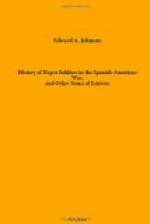[Illustration: FIRST PRESIDENT OF THE CUBAN REPUBLIC.]
Some days later, Lieutenant Roberts had occasion to visit Chicago and Fort Sheridan, and while there he was interviewed by a representative of the Chicago Chronicle, to whom he related practically the same story as above stated, “You probably know my regiment is made up exclusively of Negroes except for the commissioned officers, and I want to say right here that those men performed deeds of heroism on that day which have no parallel in the history of warfare. They were under fire from six in the morning until 1:30 in the afternoon, with strict orders not to return the hail of lead, and not a man in those dusky ranks flinched. Our brigade was instructed to move forward soon after 1 o’clock to assault the series of blockhouses which was regarded as impregnable by the foreign attaches. As the aide dashed down our lines with orders from headquarters the boys realized the prayed-for charge was about to take place and cheered lustily. Such a charge! Will I ever forget that sublime spectacle? There was a river called San Juan, from the hill hard by, but which historians will term the pool of blood. Our brigade had to follow the course of that creek fully half a mile to reach the point selected for the grand attack. With what cheering did the boys go up that hill! Their naked bodies seemed to present a perfect target to the fire of the dons, but they never flinched. When the command reached the famous stone blockhouse it was commanded by a second sergeant, who was promoted on the field of battle for extraordinary bravery. San Juan fell many minutes before El Caney, which was attacked first, and I think the Negro soldiers can be thanked for the greater part of that glorious work. All honor to the Negro soldiers! No white man, no matter what his ancestry may be, should be ashamed to greet any of those Negro cavalrymen with out-stretched hand. The swellest of the Rough Riders counted our troopers among their best friends and asked them to their places in New York when they returned, and I believe the wealthy fellows will prove their admiration had a true inspiration.”
Thus we see that while the various newspapers of the country are striving to give the Rough Riders first honors, an honest, straightforward army officer who was there and took an active part in the fight, does not hesitate to give honor to whom honor is due, for he says, “All honor to the Negro soldiers,” and that it was they who “saved the Rough Riders from destruction.” And right here I wish to call the reader’s attention to another very important matter and that is, while it has been said heretofore that the Negro soldier was not competent to command, does not the facts in the case prove, beyond a doubt, that there is no truth in the statement whatever? If a white colonel was “competent” to lead his command into the fight, it seems that a colored sergeant was competent extraordinary, for he not only went into the fight, but he, and his command, “done something,” done the enemy out of the trenches, “saved the Rough Riders from destruction,” and planted the Stars and Stripes on the blockhouse.




